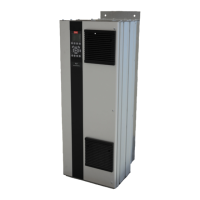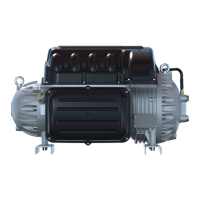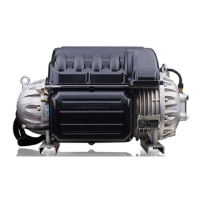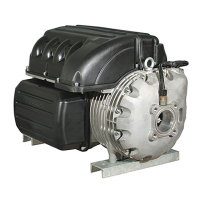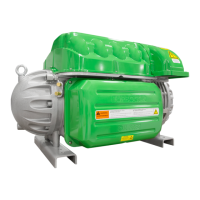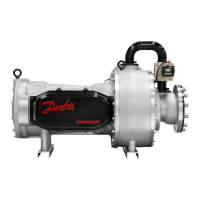249 of 282
M-SV-001-EN Rev. G
Motor Fault
Descritpion
Trigger
Method
Troubleshooting
DC Bus Under/Over
Voltage Fault
DFT • At 0 RPM: If the measured DC Bus voltage is lower than Soft Start charge voltage, a DC bus voltage fault is
recorded. All 3-phase voltage information displayed in the SMT is calculated from DC bus voltage, as measured by
the Inverter.
• Typically, this fault is recorded when power to the compressor is removed.
• Measure the incoming main AC voltage.
• Compare the measured voltages to the displayed readings in the Compressor Monitor Tool and Fault and Event
Log details to determine conditions related to the fault.
• Measure the DC bus voltage using the DC Bus Test Harness. Refer to "1.10.1 General Verification and Installation of
the DC Bus Test Harness" on page 22.
• Verify the Soft Start. Refer to "4.15.2 Soft Start Verification" on page 109.
• Verify the SCRs. Refer to "4.19.2 SCR Verification" on page 135.
• Verify the connections to the Inverter. Refer to "4.23.2.1 Inverter Verification" on page 165.
24VDC Under/Over
Voltage Fault
RFT • Suggests the measured 24VDC supply voltage is out of range.
• Measure the 24VDC test points at the Backplane. Refer to "4.26.2.2 Backplane Verification" on page 210.
• Compare the measured voltages to the displayed readings in the Compressor Monitor Tool and Fault and Event
Log details to determine conditions related to the fault.
• If the measured voltage is incorrect, verify the DC-DC Converter. Refer to "4.25.2 DC-DC Converter Verification" on
page 201.
• Determine that one of the modules is not draining energy. Refer to "5.5.2 Determining the Cause of an Energy
Drain" on page 257.
• If the fault occurs when the compressor is given the demand to run, the Inverter may be causing the 24VDC fault.
Low Motor Back
EMF
Fault
DFT • The calculated magnetic strength of the shaft has fallen below the minimum limit. This can be a temporary effect
due to high load and elevated temperatures (will recover when cavity temperature cools) or due to a permanent
demagnetization of the shaft.
• If this fault occurs three times within a 30-minute period, a Lock-Out Fault will occur.
• Compare the Back EMF value to the displayed readings in the Compressor Monitor Tool and Fault and Event Log
details to determine conditions related to the fault.
• Permanent damage to Back EMF can be caused by insufficient motor cooling, repeated overheating of cavity,
faulty Inverter, faulty BMCC, repeated Rotor May Be Locked or Single phase Over-Current faults. See Inverter Error.
• Verify the Inverter. Refer to "4.23.2.1 Inverter Verification" on page 165.
• Verify the Stator. Refer to "4.24.4 Motor Verification" on page 192.
Generator Mode
Active
DFT • Indicates, at greater than 0 RPM, the measured actual DC Bus voltage has fallen below the Generator Mode
Enabled Level value. Also, could be electronic “noise” when no actual drop in voltage has occurred.
• Measure the incoming main AC voltage.
• Measure the DC bus voltage using the DC Bus Test Harness.
• Compare the measured voltages to the displayed readings in the Compressor Monitor Tool and Fault and Event Log
details to determine conditions related to the fault.
• Typically, this fault is recorded when power to the compressor is removed while it is running.
EEPROM Checksum
Fault
INS • Indicates there is an error reading the EEPROM in the BMCC.
• Perform a bearing calibration and save to EEPROM, cycle the power.
• If the error is still present, the BMCC must be replaced.
SCR Ripple Voltage
Fault
AFT • Indicates that a voltage imbalance may exist between the incoming AC phases.
• Measure the difference in current and voltage between the phases.
• If there is a current imbalance (more than 5%) between the phases, verify the incoming AC power supply.
• Review the Compressor Monitor Tool for SCR Voltage Ripple readings at the time of the fault.
• Phase imbalance can be caused by a faulty SCR, SCR Gate, Gate control from the Soft Start Board, or a faulty power
capacitor.
• Verify the SCRs. Refer to "4.19.2 SCR Verification" on page 135.
• Verify the Soft Start Board. Refer to "4.15.2 Soft Start Verification" on page 109.
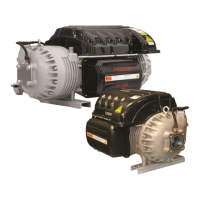
